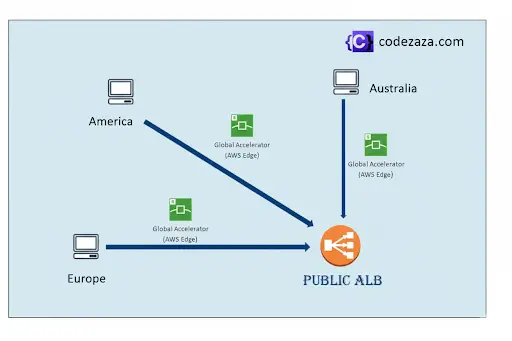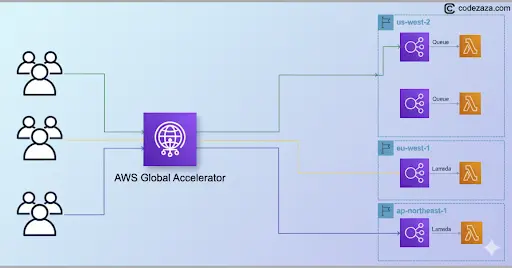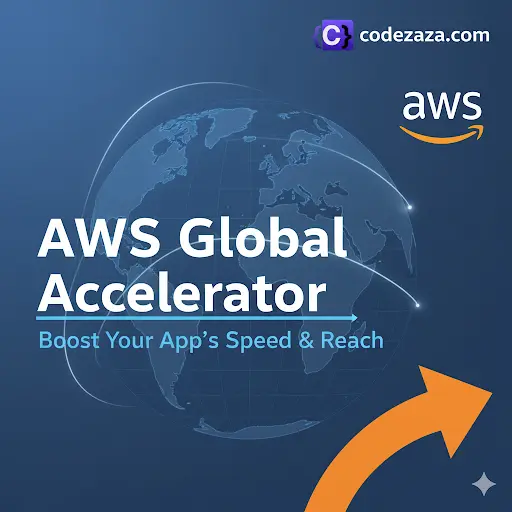AWS Global Accelerator is a powerful service that boosts the performance of applications for users worldwide. Imagine you’ve built an app hosted in one AWS region, such as India, using a Public Application Load Balancer (ALB). While it works fine for local users, your audience may also be in the United States, Europe, or Australia.
When users from these regions access your app over the public internet, their requests pass through many routers and servers. Each of these “hops” adds delays, increasing latency and slowing down the overall experience. This means users far from your AWS region often face slow load times and unreliable connections.
AWS Global Accelerator solves this issue by routing traffic through Amazon’s secure, high-performance global network. Instead of relying on the unpredictable public internet, user requests travel the fastest and most efficient path to your application. This reduces latency, increases availability, and delivers a smooth experience for users across the globe.

.
We wish to go as fast as possible through the AWS network to minimize latency. So for this problem we use the AWS global accelerator.

AWS Global accelerator:
The Global Accelerator provides two static Anycast IPv4 (2 Anycast IPs are created for your application) addresses. The Anycast IP sends traffic on to Edge Locations. Then, the AWS edge locations will send the traffic to your application All you would like to try to do is to define endpoints in one or multiple regions. It works with the following endpoints.
- Application Load Balancer (ALB)
- Network Load Balancer (NLB)
- Elastic IP
- EC2 Instance (with or without Public IP)
The Global Accelerator optimizes the route for every client, which suggests it minimizes the number of hops until a TPC or UDP package enters Amazon’s network and thus reduces latencies. Also, the Global Accelerator route requests healthy endpoints only.

To improve the performance of your applications for clients i.e users. Depending on the type of accelerator you choose. There are two types of accelerators.
- Standard accelerator: It improves the supply and performance of your applications running on Application Load Balancers(ALB), Network Load Balancers(NLB), or Amazon EC2 instances. Accelerator routes client traffic across regional endpoints supported geo-proximity and endpoint health. And It also allows customers to shift client traffic across endpoints supported controls like traffic dials and endpoint weights.
- Custom routing accelerator: Permits you to use application logic to directly map one or more users to a selected Amazon EC2 instance among many destinations while gaining the performance improvements of routing your traffic through Global Accelerator. Endpoints for custom routing accelerators must be virtual private cloud (VPC) subnets.
Here are the steps to deploy your global accelerator.
- Firstly, you have Create a Global accelerator, provided two static Anycast IP addresses.
- Your AWS Global Accelerator to know where to listen for traffic, So you will need to add in a listener (for example TCP port 80).
- Configure the endpoint groups.
- After configured an endpoint group, and now you’ll add/configure the particular endpoint. This is often the destination location where accelerator goes to send traffic and click the create button
- Then the AWS global accelerator takes about few minutes to move from the In Progress in to Deployed status.Once it’s deployed. You can the see to two static anycast IP addresses and the given DNS name for the accelerator.
Components of AWS Global Accelerator
AWS Global Accelerator works by combining several key components that make it faster and more reliable for global applications. Let’s break them down in simple terms.
1. Anycast IP Address
An Anycast IP address is a unique type of IP where multiple servers share the same address. When a user connects, their traffic is automatically routed to the nearest available server holding that IP. For example, if Global Accelerator assigns you an IP like 12.34.56.78, users in the U.S. will connect to the closest AWS edge location in America, while users in Europe connect to the nearest AWS edge in their region. This smart routing reduces the distance data needs to travel, which in turn minimizes latency and improves response times.
2. Accelerator
An Accelerator is the core resource you create in AWS Global Accelerator. It acts like a central traffic director that routes requests from users to the best AWS endpoint using the AWS global network instead of the unpredictable public internet. The accelerator ensures that user traffic follows the fastest and most reliable path. This improves both application speed and availability, regardless of where the user is located.
3. DNS Name
Every device connected to the internet communicates using numbers known as IP addresses. However, remembering numbers is not practical for humans, so we use domain names like www.amazon.com To bridge this gap, AWS Global Accelerator integrates with Amazon Route 53, a globally distributed DNS service. Route 53 translates human-readable names into machine-readable IP addresses, acting like a phone book for the internet. This ensures that when users type in a URL, their request is directed to the correct AWS endpoint quickly and reliably.
4. Network Zone
A Network Zone is an isolated unit of AWS infrastructure used by Global Accelerator. By default, each accelerator receives two Anycast IPv4 addresses, with each address assigned to a different network zone. This design provides redundancy and fault tolerance. If one IP address becomes unavailable due to a network issue or blocking, traffic automatically fails over to the other IP address in the healthy zone. This ensures continuous application availability without requiring user intervention.
5. Listener
A Listener defines how AWS Global Accelerator processes incoming client traffic. It works based on the protocols and ports you configure. For instance, you might set up a listener to accept traffic over TCP, UDP, or both. Once traffic reaches the listener, it forwards requests to the appropriate endpoint group. This setup allows you to handle multiple types of traffic efficiently and securely while maintaining control over routing behavior.
6. Endpoint Group
An Endpoint Group is associated with a specific AWS Region. Each group contains one or more endpoints that serve user requests within that region. You can adjust traffic distribution by setting weights for each endpoint group, giving you the flexibility to route more or less traffic to certain regions. This helps balance workloads, improve performance, and ensure that applications remain available even if one region faces issues.
7. Endpoints
Endpoints are the AWS resources where your application is actually running. Supported endpoints in AWS Global Accelerator include:
- Application Load Balancers (ALB)
- Network Load Balancers (NLB)
- EC2 Instances
- Elastic IP addresses
When users connect through Global Accelerator, their requests are routed to the nearest healthy endpoint. By combining endpoints with the power of Anycast IPs and the AWS global network, you can guarantee faster connections, higher reliability, and an overall better user experience.
Use Cases
- Application scalability: As your application usage grows, you need to manage more amount of IP addresses and endpoints. Here the Global Accelerator available you to scale your application network scale in /out. By default the global accelerator allows you to associate resources, like load balancers and Amazon EC2 instances, to 2 static anycast IP addresses. Global Accelerator allows that you’ll add or remove endpoints in AWS Regions, run blue/green deployment, and do A/B testing without having to update the IP addresses in your client applications. It is mostly useful for IoT, retail, media, automotive, and healthcare use cases when which you cannot easily update client applications frequently.
- Low latency: Most of the applications, especially in gaming, media, mobile apps, and financials, for excellent user experience requires very low latency. To maintain a good user experience, Global Accelerator forwards user traffic to the appliance endpoint that’s nearest to the client, which will reduce internet latency. Global Accelerator routes traffic to the closest AWS edge location by using the Anycast IP address, then routes it to the closest regional endpoint over the AWS global network. Global Accelerator quickly reacts to updates in network performance to enhance your users’ application performance.
- Disaster Recovery: Global accelerator is automatically checked the health issues of your application, and then it routes traffic to healthy application endpoints. By using the TCP, HTTP & HTTPS health checks monitor the health of your application endpoints.
- High availability: When you created an AWS global accelerator, it allows you to associate the two anycast IP addresses that are serviced by independent network zones. So it leads to the high availability of your application
- Multi-Region: We wish to go as fast as possible through the AWS network to minimize latency, disaster recovery, higher availability, or compliance. If Global Accelerator detects that your application endpoint is failing within the primary AWS Region, it instantly triggers traffic re-routing to your application endpoint within the next available, the closest AWS Region.
- Improved performance: AWS global accelerator chooses the optimal AWS region based on the geographical location of end-users. It will reduce the first byte-latency and improves performance by the ingresses traffic from AWS end locations to the closest to your end-users through anycast static IP addresses.
Conclusion
AWS Global Accelerator is a powerful service designed to improve the performance, reliability, and availability of applications for users worldwide. By leveraging Anycast IP addresses, AWS global network routing, and endpoint groups, it ensures that user traffic reaches the closest and healthiest endpoint, reducing latency and improving user experience. Its components, including listeners, network zones, and DNS integration with Route 53, work together to provide high fault tolerance and seamless failover.
For businesses with global audiences, Global Accelerator offers a simple yet effective way to deliver fast, secure, and consistent application performance. Whether your users are in the U.S., Europe, Asia, or anywhere else, this service ensures your applications remain responsive, reliable, and globally accessible, making it an essential tool for modern cloud-based deployments.


